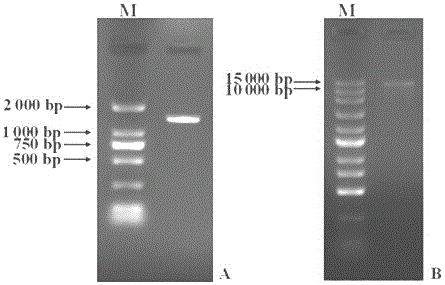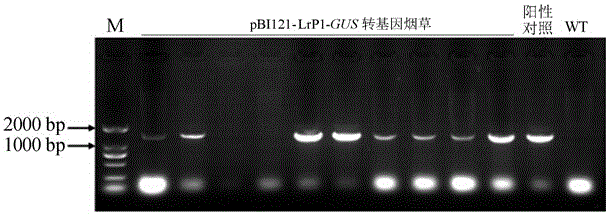Lilium regale inducible promoter and application thereof
A promoter, inducible technology, applied in the research fields of molecular biology and genetic engineering, can solve the problems of protein accumulation, waste of energy, etc., and achieve broad application prospects and the effect of protecting plants
- Summary
- Abstract
- Description
- Claims
- Application Information
AI Technical Summary
Problems solved by technology
Method used
Image
Examples
Embodiment 1
[0023] Example 1: Cloning and sequence analysis of Lilium Minjiang inducible promoter LrP1
[0024] Using the extracted Genomic DNA of Lily of the Minjiang River as a template, the specific primers for amplifying the promoter LrP1 (upstream primer: 5'TCGAGTTTGGTGTTATTGTTATTAG3'', downstream primer: 5'GATGTGTTTGAGAAGGAGGTGT3') were used as upstream and downstream primers, and the promoter was cloned by PCR Sequence of LrP1. The reaction system (20 μL) was 0.5 μg of Genomic DNA of Lily Minjiang, 2 μL of 10×Advantage 2 PCR Buffer, 1.8 μL of dNTP Mix (10mM each), 0.2 μL of upstream primer (10 μM), 0.2 μL of downstream primer (10 μM), 0.2 μL Advantage 2 PCR Polymerase Mix, 14.6 μL PCR-Grade Water. PCR reaction conditions: 94°C for 5 min; 32 cycles of 94°C for 30 s, 65°C for 30 s, and 72°C for 2 min; 72°C for 5 min. After PCR, 8 μL was taken for agarose gel electrophoresis to detect the specificity and size of the amplified product.
[0025] The PCR product obtained has only one ...
Embodiment 2
[0028] Example 2: LrP1 -GUS Expression vector construction
[0029] The pBI121 multiple cloning site has Hin dⅢ and Bam HI restriction sites, so specific primers for amplifying promoters were added Hin dⅢ and Bam HI recognition site. The Escherichia coli plasmid pGEM-T-LrP1 inserted into LrP1 and the plant expression vector pBI121 plasmid were extracted using the SanPrep column plasmid DNA mini-extraction kit (Shanghai Sangong), and 1 μL was used for agarose gel electrophoresis to detect the extracted The integrity and concentration of the plasmid. restriction endonuclease Bam HI and Hin dⅢ Carry out double digestion of plasmids pGEM-T-LrP1 and pBI121 respectively (100 μL system). The reaction system and operation process are as follows: take 20 μL pGEM-T-LrP1 and pBI121 plasmids respectively, add 10 μL 10×H buffer, 5 μL Bam HI, 5 μL Hin dIII, 60 μL ddH 2 O, after mixing, centrifuge for a short time, and place at 37°C for overnight reaction. All digested p...
Embodiment 3
[0032] Example 3: Plant genetic transformation mediated by Agrobacterium and screening of transgenic plants
[0033] The transgenic recipient in this experiment was tobacco. The tobacco seeds were soaked in 75% alcohol for 30 s, washed with sterile water and washed with 0.1% HgCl 2 Soak for 8 minutes, then wash several times with sterile water, sow on 1 / 2 MS medium, culture in dark at 28°C for 5-8 days, transfer to light incubator after germination (25°C, 16h / d light), Subculture once a month with MS medium.
[0034] The pBI121-LrP1 containing pBI121-LrP1 -GUS The plasmid Agrobacterium LBA4404 bacterial fluid was taken out, and 10 μL of the bacterial fluid was inoculated into 1 mL of LB liquid medium containing 20 mg / L rifampicin and 50 mg / L Km, and cultured with shaking at 200 rpm at 28 °C until turbid. Pipette 500 μL of bacterial liquid and evenly spread it on LB solid medium containing 20 mg / L rifampicin and 50 mg / L Km, and culture it upside down at 28°C until a lawn gro...
PUM
 Login to View More
Login to View More Abstract
Description
Claims
Application Information
 Login to View More
Login to View More - R&D
- Intellectual Property
- Life Sciences
- Materials
- Tech Scout
- Unparalleled Data Quality
- Higher Quality Content
- 60% Fewer Hallucinations
Browse by: Latest US Patents, China's latest patents, Technical Efficacy Thesaurus, Application Domain, Technology Topic, Popular Technical Reports.
© 2025 PatSnap. All rights reserved.Legal|Privacy policy|Modern Slavery Act Transparency Statement|Sitemap|About US| Contact US: help@patsnap.com



